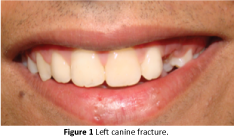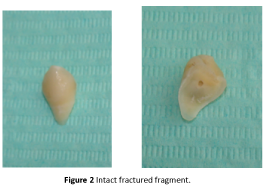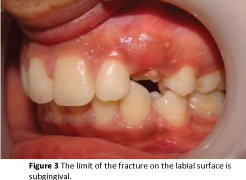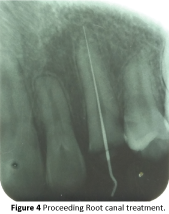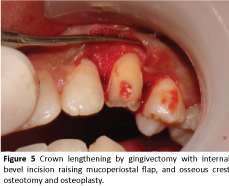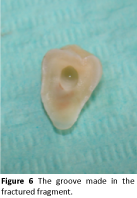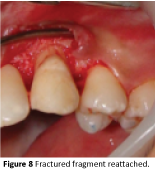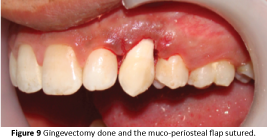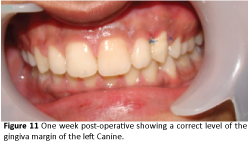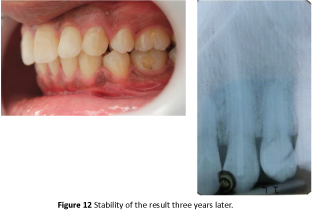Keywords
Fiber post; Reattachment; Trauma; Tooth fracture
Introduction
Teeth trauma management is not a daily task in our practice, it is
usually an emergency that needs immediate care, quick decision
making and a ‘wise’ treatment choice.
Traumatic dental injuries in permanent teeth are mostly fractures,
about 26-76%. Anterior teeth are the most involved, especially
the maxillar incisors (because of their anterior position in the
arch, protrusion) [1].
Etiological factors of crown and crown-root fractures of the
permanent dentition are falls, sport injuries, car accidents and
foreign bodies striking the teeth [2-4].
The ultimate goal of any dental emergency treatment is to reestablish
normal tooth position together with normal function
[5,6]. Numerous techniques to restore fractured crowns have
emerged in the recent years [7]. These modalities are different
whether the fractured fragment is available and intact [2,6].
Indirect restoration techniques including stainless steel crowns,
porcelain bonded crowns, or jacket crowns, and direct restoration
with minimal preparation (using composite resin with acid etch
adhesive techniques), are used when the tooth fragment is
unfound or damaged [2,6].
The reattchment of a fractured crown using adhesive technique
could be the first line of treatment if the fractured portion is
intact, and the margins are preserved. This technique can be
reinforced with the use of a post as it interlocks the two fragments
and minimizes the stress on the reattached fragment [4]. This
option, is a promising alternative that can offer many benefits
when chosen at the conclusion of a complete analysis of the case.
Case Report
A 15 year old male patient came to our dental office after trauma
caused by a fall during a soccer game some hours earlier. The
patient’s medical history was not significant. At first, soft tissue
examination revealed no injuries of the lips, but a marginal
inflammation of gingiva at the fractured tooth. In fact, hard
tissue examination showed a crown fracture of the maxillary left
canine (Figure 1). The patient had stored the fractured segment (Figure
2). Clinical deeper intraoral examination revealed an oblique
Ellis Class III fracture, extending from cronal aspect palatally to
gingival aspect labially. The limit on labial surface was located
about 3 mm from the free gingival margin and could be probed
easily with a periodontal probe (Figure 3). The fractured segment
was immediately placed in an isotonic solution to prevent discoloration and dehydration.
Figure 1: Left canine fracture.
Figure 2: Intact fractured fragment.
Figure 3: The limit of the fracture on the labial surface is subgingival.
Pulp exposure was clinically obvious and a preoperative periapical
radiograph confirmed it.
No traumatic occlusion was observed. The fractured fragment
was checked. It had no structure loss, had intact edges, and was
adapted to the remaining tooth structure.
The treatment options explained to the patient were:
1/ Endodontic treatment followed by orthodontic traction, then
a post and core with all ceramic or ceramic fused metal crown
2/ Endodontic treatment followed by reattachment of the
fractured tooth fragment.
After discussing advantages and disadvantages of each option,
the patient opted for the tooth fragment reattachment.
Treatment procedure
An isolation of the operative field was achieved using cheek
retractor, cotton rolls and saliva ejector placed in position. The
endodontic treatment (Figure 4) was performed and completed.
A crown lengthening, by gingivectomy with internal bevel incision
and raising mucoperiostal flap, then osseous crest remodeling by
osteotomy and osteoplasty, was accomplished to expose the line of fracture, and the bleeding was controlled (Figure 5).
Figure 4: Proceeding Root canal treatment.
Figure 5: Crown lengthening by gingivectomy with internal bevel incision raising mucoperiostal flap, and osseous crest osteotomy and osteoplasty.
The post space was prepared in both radicular portion of the
tooth as well as in the fractured fragment removed from the
isotonic solution (Figure 6). A light-transmitting fiber post was
tried in the canal and cut at the desired length. The fractured
fragment was tried on the cut end of the fiber post to confirm
that it fits the groove made in it.
Figure 6: The groove made in the fractured fragment.
The fiber post was cemented into the canal using dual cured resin
cement. Any excess cement oozing out of the canal was removed
so as not to compromise the fit of the coronal fragment (Figure 7).
Figure 7: Fiber post tried, cut to the right length and cemented.
The exposed root surface and the fractured fragment were acid
etched simultaneously. The groove in the fractured fragment was
filled with dual-cure resin cement. The fragment was repositioned
and cured from palatal and labial surface for 40 s each (Figure 8).
Then the mucoperiosteal flap was sutured (Figure 9).
Figure 8: Fractured fragment reattached.
Figure 9: Gingevectomy done and the muco-periosteal flap sutured.
The functional occlusion of the canine was transformed from
canine protected occlusion to an anterior group function (canine,
lateral and central incisor) in order to minimize the stress on the
reattached fragment (Figure 10).
Figure 10: The left canine occlusion modified.
The patient was instructed to rinse with a 0, 12% chlorhexidine gluconate solution, twice daily for 7 days. One week later the
suture were removed, and the occlusion was checked (Figure 11).
Three years later, we notice a good stability of the periodontium,
and the esthetic result (Figure 12).
Figure 11: One week post-operative showing a correct level of the gingiva margin of the left Canine.
Figure 12: Stability of the result three years later.
Discussion
Fractured anterior teeth cause the patient pain, fear and
emotional concern about his or her appearance [8]. An immediate
restoration of the esthetic appearance by preserving the natural
tooth is usually the best option to offer these patients.
Several case reports explain the success of the reattachment of uncomplicated tooth fracture cases. When the fractured fragment
is intact and available, fragment reattachment may offer a most
functional and esthetic treatment option, even for complicated
fracture cases, as shown in the present report.
The tooth fragment reattachment may offer the following
advantages [4,9]:
✦ Better esthetics, as shade matching and translucency will be
perfect
✦ Minimal invasive technique especially with actual advances in
dentinal adhesives,
✦ Incisal edge will wear at a rate similar to that of the adjacent
teeth
✦Functional rehabilitation
✦Replacement of fractured portion may be less time consuming
than what is needed for completion of a provisional restoration
✦A positive emotional and social response from the patient for
preservation of natural tooth structure
✦ Considered and used as a transitional restoration for a young patient
Factors influencing the feasibility of such repairs include the site
of fracture, size of fracture remnants, periodontal status, pulpal
involvement, biological width invasion, occlusion, and time and
resources of the operator and the patient [4,6,9].
Depending on these factors, various treatment options are:
✦ Reattachment of fractured fragment
✦ Composite restoration
✦ Orthodontic traction
✦ Crown lengthening
Followed by post and core supported restorations [4,10].
The reattachment of the fractured fragment can be indicated
when the fracture site has an easy access, and the size of the
fracture is significant. However this option is only possible under
some conditions. The remnant fragment has to be intact and
kept hydrated and it has to fit accurately onto the tooth without
compromising the occlusion. The use of a post depends on the
size of the fracture and the pulpal involvement.
A damaged or lost remnant fragment or its small size may
indicate a composite restoration. While as the orthodontic or
surgical extrusion cannot be avoided when the periodontium
is damaged. In fact they are indicated when the fracture line is
extended below the alveolar crestal bone with a biological width
invasion [4,9]. However, this alternative can impair good esthetic
resolution because the cervical diameter of the extruded tooth is
smaller than that of the adjacent tooth. Also, the time required
to achieve the final results is longer, considering the period of
extrusion and stabilization.
In the present case, clinical examination revealed pulpal
involvement which indicates an endodontic treatment. The
fractured fragment was intact and correctly fitted onto the
apical fragment. Since the line fracture extended subgingivally,
an access to the most cervical margin of the fracture, without
esthetical mutilation of the patient, was required, hence the
mucoperiosteal flap with gingivectomy.
According to the amount of the restoration, posts could be used
to support the fragment [11]. Their use increases retention and
distributes stress along the root. In addition, using fiber post
along with self/light cured resin cement, as in the present case,
gives a monobloc effect, protecting the bond from rotational and
twisting forces that may reduce the potential of success [4,10].
Early retrospective studies indicate that clinical performance of
fiber posts is promising and the failure rate recorded is 3, 2% over
a period of 4 years [12].
The bonding of the post and the fragment during the surgical
procedure is less time consuming, and allows an accurate cervical
margin adaptation of the crown fragment. However, it requires
perfectly efficient moisture and bleeding control achieved, in this
case using cheek retractor, cotton rolls and saliva ejector placed
in position since placing a rubber dam was not possible. Suturing
the mucoperiosteal flap after bonding was in order to avoid the
presence of any periodontal seep that could have compromised
resin bonding adhesive application and success of the treatment.
The reattachment of fractured coronal fragments have shown successful short- and medium-term results according to reports
and clinical experience [11,13,14].
Cavaller et al. reported a better long-term prognosis for the
reattachment of crown fracture comparing to composite resin
restorations [15].
The study conducted by Yucel et al. evaluating the restored teeth
using reattachment technique of fractured fragment to the remaining
tooth, showed a successful result after a 24 months follow up [16].
In this case the duration of the reattachment has lasted 3 years,
with no separation of the crown fragment. The tooth was evaluated
clinically and radiographically (Figure 12) in order to control esthetic,
occlusion, pulpal and periodontal results. We noticed neither color
variation of the reattached fragment, nor resorption or mobility.
The improvements in the resin dental materials and the new
generation bonding agents contributes to the success of this
alternative treatment.
Conclusion
Reattachment of fractured fragment is an option that provides
immediate esthetic, functional and biologic restoration. It could
be the first choice for crown fractures of anterior teeth as it can
be the most conservative and less time consuming treatment.
The main conditions to indicate and succeed this alternative
treatment are intact edges of the fractured fragment, easy
access to the fracture line, and an adequate isolation during the
procedure.
References
- Andreason JD, Andreason FM, Andreason L (2007) Textbook and color atlas of traumatic injuries to the teeth. 4th edn, John Wiley & Sons Inc, USA, pp: 280-290.
- Patni P, Jain D, Goel G (2010) A holistic approach to management of fractured teeth fragments: a case report. Oral Surg Oral Med Oral Pathol Oral Radiol Endo 9: e70-e74.
- Akhil R, Ataide I, Fernandes M (2009) Uncomplicated crown fracture, complicated crown-root fracture, and horizontal root fracture simultaneously treated in a patient during emergency visit: a case report. Oral Surg Oral Med Oral Pathol Oral Radiol Endod 107: e48-e52.
- Anil KS, Jyothi KN (2010) Reattachment of fractured tooth using self-etching adhesive and esthetic fiber post. Journal of Dental Sciences and Research 1: 75-83.
- Olsburgh S, Jacoby T, Krejci I (2002) Crown fractures in the permanent dentition. Dent Traumatol 18: 103-115.
- Londhe SM, Garge HG, Sudeep S (2008) Reattachment of crown fragment for immediate esthetics. MJAFI 64: 387-388.
- Skapetis T, Curtis K (2010) Emergency management of dental trauma. Australian Emergency Nursing Journal 13: 30-34.
- Mader C (1978) Restoration of a fractured anterior tooth. J Am Dent Assoc 96: 113-115.
- Darda SS, Manwar NU, Chandak MG, Shori DD (2008) Fracture reattachment: functional and aesthetic alternative: Case report. JFPA 22: 72-75.
- Macedo GV, Diaz P, Augusto C (2008) Reattachment of anterior tooth fragments: a conservative approach. Journal of Esthetic and Restorative dentistry 20: 5-20.
- Attila OI, Cenk HM, Toroglu MS (2006) Multidisciplinary approach to the rehabilitation of a crown-root fracture with original fragment for immediate esthetics: a case report with 4-year follow-up. Dental Traumatology 22: 48-52.
- Ferrarin AV, Mannochi F, Mason PN (2000) Retrospective study of the clinical performance of fiber posts. American Journal of dentistry 13: 9B-13B.
- Maia EA, Baratieri LN, Andrada MA (2003) Tooth fragment reattachment: fundamentals of the technique and two case reports. Quintessence Int 34: 99-107.
- Baratieri LN, Monteiro S, Andrada MAC (1990) Tooth fracture reattachment: case reports. Quintessence Int 21: 261-270.
- Cavalleri G, German N (1995) Traumatic crown fractures in permanent incisors with immature roots: a follow-up study. Endod Dent Traumatol11: 294-296.
- Yucel Y, Cigdem Z, Ozge E, Nihal B (2008) Evaluation of success in the reattachment of coronal fractures. Dental Traumatology 24: 151-158.

